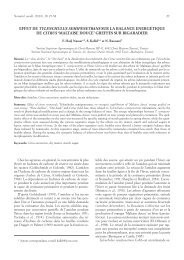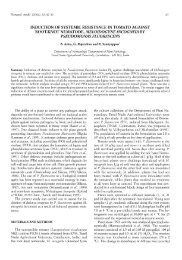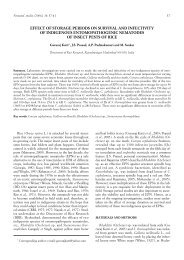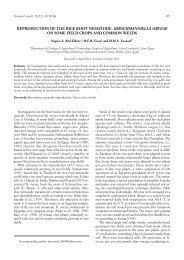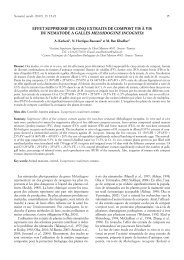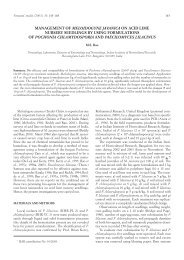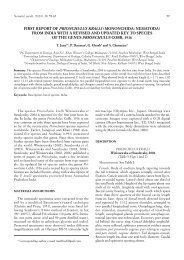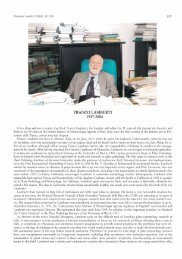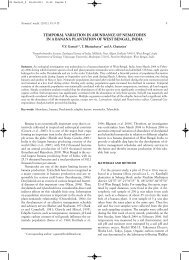PASTEURIA PENETRANS INFECTING MELOIDOGYNE SPP.
PASTEURIA PENETRANS INFECTING MELOIDOGYNE SPP.
PASTEURIA PENETRANS INFECTING MELOIDOGYNE SPP.
- No tags were found...
Create successful ePaper yourself
Turn your PDF publications into a flip-book with our unique Google optimized e-Paper software.
194pared to glistening white healthy females, as describedby Mankau and Imbriani (1975). The other part of theinfected roots was soaked in tap water in glass beakersfor 3-4 days or until the roots became softened (Ratnasomaand Gowen, 1996). Adult females of Meloidogynespp. were then separated from the softened roots, bywashing under a vigorous jet of tap water onto 500 µmand 250 µm sieves, collected in distilled water in a smallflask and then examined for their infection by P. penetrans.Mature females were crushed in a little drop ofwater on a glass slide, covered with a cover slip andthen examined for the presence of P. penetrans endosporesor other stages of the life cycle under a microscopeat 400× magnification.Image analysis and studies with transmission electronmicroscope at 15000×, 20000× and 30000× magnificationof mature P. penetrans spores from infected adultfemales of M. javanica were also done at the RegionalCenter for Mycology and Biotechnology, Al-Azhar University,Nasser city, Cairo, Egypt.Pasteuria penetrans was detected in J 2and mature femalesof the root-knot nematodes, in soil or root samples,respectively, only in the Kom Hamada region, El-Behira governorate. Pasteuria penetrans was found in femalesand adhering to the cuticle of J 2of M. javanica oninfected eggplant (Figs 1A, B).The studies with the transmission electron microscopeshowed that diameter and height of the endospores were3.35 µm and 1.42 µm, respectively (average of 19 spores)(Figs 2 and 3). Spore shape and size of this isolate of P.penetrans are similar to those reported by Sayre and Starr(1985) infecting root-knot nematodes. The low occurrenceof P. penetrans in the selected area, on vegetablecrops, may be due to the use of pesticides and herbicides,which are used frequently in these fields and may be thecause of low natural infection in these locations (Verdejo-Lucas et al., 1997). The sandy soil texture of the examinedlocation may also have contributed to the migrationof the bacterium spores into deeper soil layers followingirrigation (Shahid et al., 2010). The attachment rates maybe variable due to the specificity of P. penetrans to differentMeloidogyne populations of the same species, withina country or even within the same area (Tzortzakakis,2008).Fig. 1. A: Spores of the detected Egyptian isolate of Pasteuria penetrans attached to asecond-stage juvenile of Meloidogyne sp.; B: Females of Meloidogyne sp. infected withthe Egyptian isolate of P. penetrans.Fig. 2. Spores of the Egyptian isolate of P. penetrans. A: Under light microscope at400× with Image Analysis System; B: Different shape of the spores at 15000× underTransmission Electron Microscope (Scale bar = 500 nm).
Bakr et al. 195Fig. 3. Spores of the detected Egyptian isolate of P. penetrans (Pp EGY) under TransmissionElectron Microscope. A: Showing the infection tube (it) at 20000×; B: Onespore at the magnification 30000×. Scale bars = 500 nm.Our survey broadens information on the presence ofthe endoparasitic bacterium P. penetrans in Egypt, previouslyreported by El-Saedy and Mokbel (2007). Furtherinvestigations should be undertaken to explore thefeasibility of using this local isolate of the bacterium fornematode management under field conditions.LITERATURE CITEDChaudhary K.K. and Kaul R.K., 2010. Effect of the time ofapplication on the biocontrol efficacy of Pasteuria penetransagainst root-knot nematode Meloidogyne incognita.Journal of Phytology, 2/7: 70-74.Chen Z.X. and Dickson D.W., 1998. Review of Pasteuria penetrans:biology, ecology and biological control potential.Journal of Nematology, 31: 313-340.Davies K.G., De Leij F. and Kerry B.R., 1991. Microbialagents for the biological control of plant parasitic nematodesin tropical agriculture. Tropical Pest Management,37: 303-320.El-Saedy M.A.M. and Mokbel Asmaa A., 2007. Control of theroot-knot nematode, Meloidogyne incognita using twoEgyptian isolates of Pasteuria penetrans. Egyptian Journalof Phytopathology, 35(2): 125-139.Hartman K.M. and Sasser J.N., 1985. Identification ofMeloidogyne species on the basis of differential host testand perineal-pattern morphology. Pp. 69-77. In: An AdvancedTreatise on Meloidogyne - Vol. II Methodology(Barker K.R. and Carter C.C. eds). North Carolina StateUniversity Graphics, Raleigh, USA.Mahdy M.E., 2002. Biological control of plant parasitic nematodeswith antagonistic bacteria on different host plants.Ph.D. dissertation, Bonn University, Bonn, Germany, 182pp.Mankau R. and Imbriani J.L., 1975. The life cycle of an endoparasitein some tylenchid nematodes. Nematologica, 21:89-94.Mousa E.M. and Mahdy M.E., 2006. Differential rate in sporeattachment of seven isolates of Pasteuria penetrans on theroot-knot nematode Meloidogyne javanica. Journal of Nematology,38: 284 (Abstract).Mousa E.M., Mahdy M.E. and Bakr R.A., 2008. Pasteuria penetransas a biological control agent of root-knot nematodes inEgypt. 5 th International Congress of Nematology, 13-18 July2008, Brisbane, Queensland, Australia, p. 78 (Abstract).Ratnasoma H.A. and Gowen S.R., 1996. Spore attachment ofPasteuria penetrans on juveniles of Meloidogyne incognitaas affected by pH and organic matter. NematologiaMediterranea, 24: 283-285.Sayre R.M. and Starr M.P., 1985. Pasteuria penetrans (ExThorne, 1940) nom. rev., comb. n., sp. n., a mycelial andendospore forming bacterium parasitic in plant parasiticnematodes. Proceedings of the Helminthological Society ofWashington, 52: 149-165.Sayre R.M. and Starr M.P., 1988. Bacterial diseases and antagonismof nematodes. Pp. 69-101. In: Diseases of Nematodes(Poinar G.O. and Jansson H.B., eds). CRC Press,Boca Raton, Florida, USA.Shahid M., Rehman A.U. and Javed N., 2010. Occurrence ofPasteuria penetrans in the fields of vegetable crops in Punjab,Pakistan. Pakistan Journal Nematology, 28: 329-333.Southey J.F., 1986. Laboratory methods for work with plantand soil nematodes. Ministry of Agriculture, Fisheries andFood, HMSO, London, UK, 202 pp.Stirling G.R., 1985. Host specificity of Pasteuria penetranswithin the genus Meloidogyne. Nematologica, 31: 203-209.Sturhan D., 1988. New host and geographic records of nematodeparasitic bacteria of the Pasteuria penetrans group.Nematologica, 34: 350-356.Tzortzakakis E.A., 2008. Attachment of Pasteuria penetransspores on populations of Meloidogyne javanica and M.incognita virulent and avirulent on the Mi gene of resistanttomato. Helminthologia, 45: 54-56.Accepted for publication on 3 June 2011.





